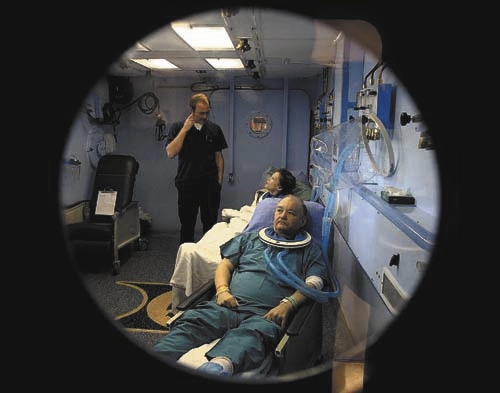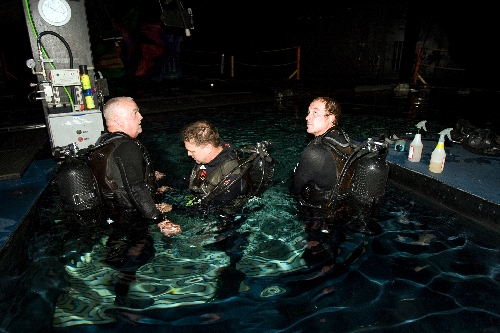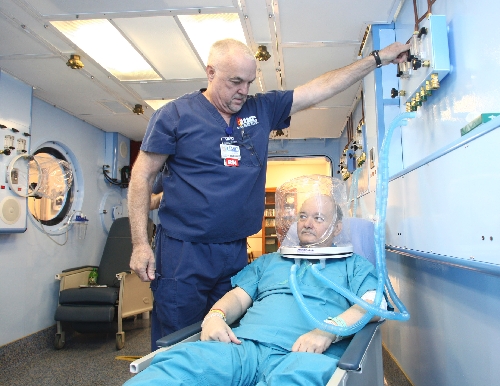UMC and ‘Le Reve’ pool their resources
As acrobats in "Le Reve," the aqua spectacle at Wynn Las Vegas, dropped as much as 80 feet into the pool below, two specialists from University Medical Center watched their entry from underwater.
Richard B. "Gus" Gustavson and Chad McFarlin, whose speciality in hyperbaric medicine includes treatment of diving disorders, had been invited by the show's management to observe how a critical, yet unseen, part of the elaborate theatrical experience -- the work of underwater stage hands -- is carried out.
"If they're more aware of our divers' duties here, it should be easier to know how to treat them if they ever run into trouble," said Rick Woolworth, head of aquatics for "Le Reve," before the UMC pair put on scuba gear to watch a Saturday performance. "Plus it's an extra set of eyes on our safety measures."
Fourteen "Le Reve" divers spend the entire 75 minutes of the show underwater, escorting performers "offstage" with breathing apparatus as they leave the pool area. The divers also move heavy scenery around.
No one in the "Le Reve" production, Gustavson and McFarlin noted after they left the pool, was ever in danger of ascending from the water too quickly. That can cause air bubbles to form in the bloodstream and tissues of the body, compressing nerves and obstructing arteries, veins and lymphatic vessels, while triggering harmful chemical reactions in the blood.
"If that were to happen and a diver got what is called an air embolism, they'd be sent to UMC's hyperbaric chamber immediately," Gustavson said. "It's potentially fatal."
Hyperbaric medicine is also known as hyperbaric oxygen therapy, where pure oxygen is administered in a high-pressure chamber. It has been around in one form or another for more than 300 years.
At first blush, the fact that a UMC team of experts in hyperbaric medicine was called on for consultation by an aquatic show's management does not seem all that unusual. After all, the hyperbaric chamber was introduced in the 19th century to aid divers who suffered from work-related disorders. Emergency use of the chamber has been effectively used for people with carbon monoxide poisoning as well as diving accidents.
But, given the prevailing use of hyperbaric chambers today in Las Vegas, it is quite strange.
"Even with Lake Mead, we don't see that many diving disorders in Las Vegas," said McFarlin, a former Army diver who worked with underwater construction and demolition devices.
At the UMC hyperbaric chamber, which holds up to 12 people, the patients who show up day after day generally are men and women with non- healing wounds, bone infections and radiation injury to bone and soft tissue.
They wear breathing hoods, which allow each patient to receive their own high concentration oxygen supply.
A team of physicians, including Dr. J. Dylan Curry, supervises the treatment.
"It's generally an adjunctive therapy done in combination with other medical treatments," Curry said.
Hyperbaric oxygen therapy involves applying oxygen at a pressure greater than one atmosphere, the ambient pressure at sea level. In hyperbaric oxygen chambers, a patient breathes 100 percent oxygen intermittently while the pressure of the treatment chamber is increased to 2 to 3 atmospheres for a prescribed amount of time.
Scientists have found that this exposure increases the amount of oxygen in the patient's blood being delivered to organs and tissues in the body, which in turn promotes the healing of wounds.
"I think it's really helping wounds on my foot heal," said Steve Otto, a diabetic who said he had toes amputated before the treatment. "If you don't have enough oxygen, and a lot of us diabetics don't, cells can't heal the wounds."
A high level of oxygen in the blood also helps fight infections caused by a variety of bacteria, some of which live only in the absence of oxygen. The therapy also enables white blood cells to destroy many kinds of bacteria more efficiently.
Curry said hyperbaric oxygen is beneficial in treating diabetic foot ulcers and bone infections and that traumas such as crush injuries and thermal burns that deprive tissues of oxygen also benefit from high-oxygen therapy. He said it is also helpful for patients whose tissues were damaged by radiation therapy.
Hyperbaric oxygen actually can be a lifesaver for patients with diving disorders, Curry said.
Yet the chamber is used for a diver as a decompression chamber less than 10 times a year, Gustavson said. The normal atmospheric pressure people on dry land experience is known as normobaric pressure. As divers go underwater, the pressure of the water and air above them increases with depth. The additional pressure forces several changes in how a human body processes blood gases such as oxygen and nitrogen.
When a diver surfaces too quickly, gases in their blood can convert to dangerous bubbles. With a hyperbaric chamber able to basically return a diver to the same depth and pressure experienced during the actual dive, nitrogen escapes naturally, leaving only absorbable oxygen.
"I hope none of our divers have to use the chamber, but it's good to know that we have such a good one at UMC," said Rick Lovett, the assistant head of aquatics for Wynn and the man who took out Gustavson and McFarlin for an underwater swim in the Wynn Las Vegas pool before the show.
While UMC houses the first clinical rectangular chamber being used in the United States -- the inside looks more like an ordinary room rather than a medical treatment device -- there are hyperbaric chambers throughout the valley, many of them just one-person chambers.
Some individuals are using the chamber as an anti-aging device, "but there's no science to back that up," McFarlin said.
In the 1990s, singer Michael Jackson, who was pictured in a mono-hyperbaric chamber, said he thought the chamber could help people live until age 150.
A number of professional athletes, including NFL receiver Terrell Owens, have a chamber at home. They say it helps their injuries heal faster.
"Studies show that to be true," McFarlin said.
What worries McFarlin is that hyperbaric oxygen therapy has joined the ranks of unproven remedies for many conditions, particularly incurable ones such as autism and cerebral palsy.
"Insurance won't pay for those treatments, and all people are getting out of it is bankrupt and heartbreak," he said.
Medicare pays up to $350 for a covered hyperbaric treatment such as a nonhealing wound, Gustavson said, adding that commercial insurance for a diver pays nearly $1,000 for a session.
The therapy is not without risks, though most are minor and generally short-lived. They include ear and sinus pain, low blood sugar and anxiety attacks resulting from confinement in the chamber.
In 2009, a grandmother and her 4-year-old grandson were killed in the explosion of a hyperbaric chamber in Florida. The blast at the Lauderdale-by-the-Sea clinic dislodged a tube attached to a hyperbaric chamber, resulting in an explosion and flash fire, authorities said.
Because hyperbaric oxygen therapy involves the use of pressurized oxygen, McFarlin said, it is obviously a fire and explosion hazard. He said UMC and other hospitals and treatment centers follow specific safety protocols to make fire less of a hazard. Before the Florida accident, there had been no documented fatality in a chamber in more than 75 years of use in North America.
As 58-year-old Susan Jurgensen waited to undergo hyperbaric treatment at UMC, she said each session in the chamber -- three 30-minute treatments with five minute breaks in between comprise a session -- isn't tough to take.
When compression in the chamber is built up, she feels a pressure in her ears that is much like the sensation of descending in an airplane. At the end of the treatment period, when it is time to decompress, she said her ears adjust automatically.
Jurgensen said she prayed that many weeks of sessions in the chamber would help tissue in her face mend, a wound brought upon by a medical accident that she said has broken her heart.
The former model said she was over-radiated during cancer treatment in New York, and she now worries that the scarring on her nose looks like a red bulls-eye.
"I think it's healing the tissue, don't you?" she asked, tears welling in her eyes.
What will be tough to take about the treatment, she said, is if the wound on her nose won't heal.
"People say that with my makeup on they can't see it, but I know it's there. You don't know how bad I want this oxygen therapy to work."
Contact reporter Paul Harasim at pharasim@reviewjournal.com or 702-387-2908.

























